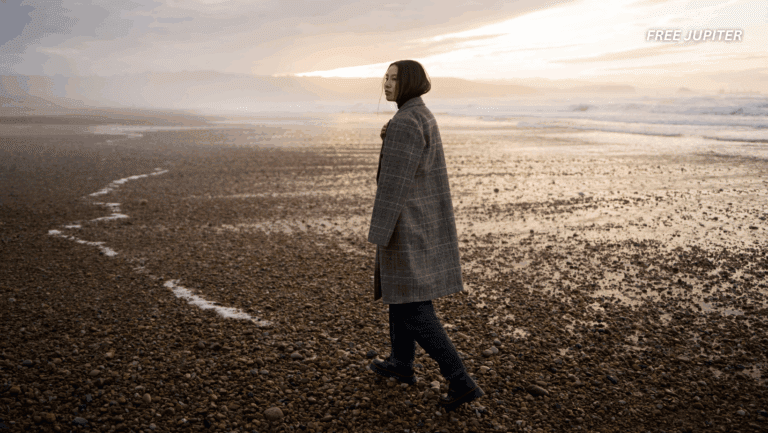Friendly Note: FreeJupiter.com shares general info for curious minds 🌟 Please fact-check all claims—and always check health matters with a professional 💙
Here’s a little nugget of nature that might just lift your spirits: sea otters hold hands while they sleep. It’s not just for show—it’s how they keep from floating away from one another in the open sea. Practical? Yes. Heart-melting? Absolutely.
These furry little marine mammals spend most of their lives in water, where they eat, play, groom, and sleep. When it’s nap time, sea otters often link paws and form what’s called a “raft”—a group of otters lazily drifting together. Holding hands helps them stick together in strong currents and prevents them from being separated while they snooze on the surface of the ocean.
But the cuteness doesn’t end there. Sea otter mothers have their own way of keeping their pups safe. When a mother needs to dive for food, she sometimes wraps her baby in seaweed like a floating cradle, anchoring it in place. That way, the little one doesn’t float away while mom hunts for clams or sea urchins beneath the waves.
Otters: More Than Just Adorable Faces
Sea otters might be the poster animals for cuteness, but they’re also hardworking and incredibly smart. Unlike many other animals, sea otters use tools—specifically rocks—to crack open tough shells. They often carry their favorite rock in a little pouch under their forearms (yes, they basically have built-in pockets).
They also play a big role in maintaining the health of their ecosystems. Sea otters love to munch on sea urchins, which are known for devouring kelp forests when left unchecked. By keeping urchin populations in balance, sea otters help protect these underwater forests, which in turn support countless other marine species.
Read more: Pigs Found To Be Smarter Than Your Dog—And Maybe Even Your Kid
From Near Extinction to a Hopeful Comeback
Sadly, sea otters haven’t always had it easy. In the 18th and 19th centuries, they were hunted relentlessly for their luxurious fur—the thickest in the animal kingdom. Their numbers dropped so dramatically that, by the early 1900s, fewer than 2,000 remained across the entire Pacific Rim.
Thanks to international conservation efforts, hunting bans, and rehabilitation programs, sea otter populations have made a remarkable comeback. Today, around 106,000 sea otters can be found across parts of the North Pacific, from Russia and Alaska to British Columbia and California. Still, their recovery isn’t guaranteed. They remain vulnerable to oil spills, fishing gear entanglements, pollution, and habitat loss.
Related Creatures With Quirky Sleep Habits: Nature’s Most Unexpected Nappers
🐬 Dolphins: Masters of the Half-Snooze
Unlike humans, dolphins don’t fully shut down when they sleep. Instead, they practice what’s called unihemispheric slow-wave sleep—which means one half of their brain sleeps while the other half stays awake. This allows them to keep swimming, come up for air (since they must breathe consciously), and remain alert for predators or obstacles.
While one eye closes, the other stays open. After a few hours, the sides switch roles. Think of it as your brain taking turns on night shift duty—efficient, if a bit odd by human standards.
Bonus fact: Some seals and whales sleep the same way. Marine life has clearly mastered the art of sleeping on the job.
🦜 Frigatebirds: Sleeping in Flight
Imagine flying for weeks over the ocean—no rest stops, no landing pads. That’s the life of the frigatebird, a seabird known to sleep while flying.
Scientists have discovered that these birds can nap mid-air, again using unihemispheric sleep. While they don’t get a full night’s rest like land birds, they grab short naps during gliding moments. One hemisphere of the brain dozes for a few seconds at a time while the other stays active enough to keep the bird airborne and avoid collisions.
It’s not exactly a comfy mattress, but it gets the job done.
Read more: Norway Declares Nationwide Ban on Deforestation In World-First
🐦 Swifts: Champions of Non-Stop Napping
Similar to frigatebirds, common swifts have been observed flying for months without landing—and yes, that includes while sleeping. Swifts can stay in the air for up to 10 months straight, catching tiny insects mid-flight and grabbing rest on the wing.
Their lightweight bodies and long wings are built for gliding, and like frigatebirds, they’re able to sleep in short bursts using one hemisphere of the brain at a time. It’s like taking a micro-nap while commuting through the skies.
🐘 Elephants: The Minimalist Sleepers
Despite their massive size and complex brains, elephants sleep far less than you’d expect—sometimes as little as 2 hours a night.
Wild elephants often sleep standing up, using light dozing periods to rest while staying alert for threats. Deeper sleep—when they lie down—happens less frequently, often just every few days. Surprisingly, elephants can also go days without sleeping at all, especially when migrating or facing danger.
Their sleep is short but efficient, possibly because of the need to remain constantly aware in the wild.
🦛 Hippopotamuses: Sleeping While Submerged
Hippos spend much of their time in water, and interestingly, they sleep while underwater too. But don’t worry—they’re not drowning.
Even while snoozing, a hippo’s body instinctively knows when to rise for air, typically surfacing every 3–5 minutes. This movement is so automatic, it doesn’t even wake them up. It’s as if their inner lifeguard is on duty at all times.
🐴 Horses: Nap Upright, Dream Lying Down
Horses have a clever trick when it comes to sleep. They’re able to nap while standing up, thanks to a unique locking mechanism in their legs called the “stay apparatus.” This lets them rest lightly without collapsing.
However, for deep, restorative sleep—known as REM sleep—they must lie down. That’s when they dream, twitch, and fully relax. But because lying down too long can cause health issues due to their weight, they keep REM sleep short and sweet.
Sea Otters in Popular Culture and Public Awareness
The charm of sea otters hasn’t gone unnoticed. They frequently appear in documentaries, children’s books, and even memes. Organizations like the Monterey Bay Aquarium in California have helped bring awareness to their plight through education and otter rescue programs. Some of their rescued otters even become surrogate moms, helping orphaned pups learn vital survival skills before being released into the wild.
Social media has also played a big part in boosting their popularity. Viral videos of otters floating on their backs or playfully juggling rocks have turned them into unlikely internet stars. But behind the cuteness lies a reminder: these animals still need protection.
Read more: The Reason Cats Prefer Sleeping on Their Left Side, According to Science
Final Thoughts: A Gentle Reminder From the Sea
Sea otters don’t just survive in their coastal habitats—they thrive through cooperation, smarts, and a whole lot of charm. Their hand-holding habit might look like a cuddly nap-time routine, but it’s also a beautiful symbol of connection and care.
In a world that often feels adrift, maybe we can learn something from these whiskered wonders: sometimes, all you need to do is reach out, hold on, and float together.
Fun Fact Recap:
- A group of otters floating together is called a raft.
- Sea otters can stay warm without blubber thanks to their 1 million hairs per square inch.
- They’re one of the few non-primate species to use tools.
- Otter moms wrap their pups in seaweed while hunting—nature’s own flotation device.
So next time you’re having a rough day, just picture a bunch of sea otters, hand in hand, gently bobbing along the ocean’s surface. It’s nature’s version of a group hug—floating and fuzzy.










